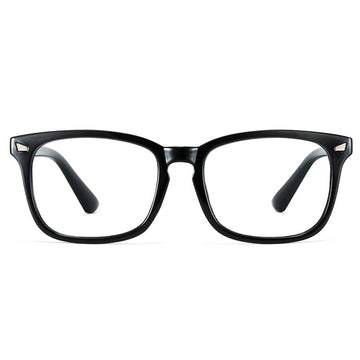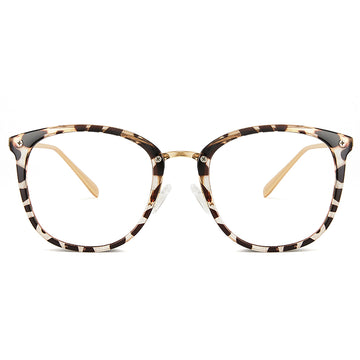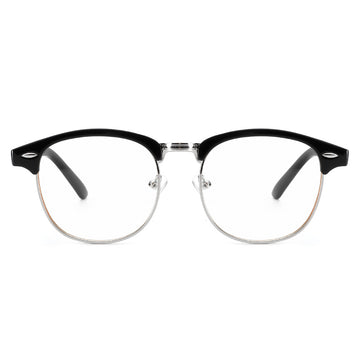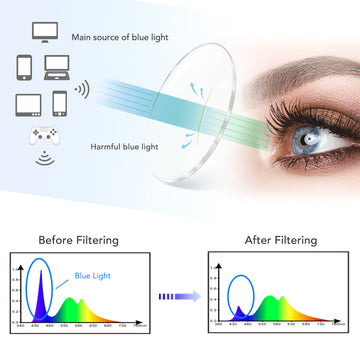How Blue Light Affects You and Your Health
What is Blue Light?
Blue light is a color in the visible light spectrum visible to human eyes. Blue light is a short wavelength, which means it produces more energy.
Light consists of electromagnetic particles that travel in waves. These waves emit energy and range in length and strength. The shorter the wavelength; the higher the energy. Every wavelength is represented by a different color and is grouped into the following categories: gamma rays, x-rays, ultraviolet (UV) rays, visible light, infrared light, and radio waves. Together these wavelengths form the electromagnetic spectrum.
However, the human eye is only sensitive to a portion of this spectrum: visible light. Visible light is that part of the electromagnetic spectrum that is seen as colors: red, orange, yellow, green, blue, indigo and violet light. When combined, it becomes the white light we see. Rays at the red end have a longer wavelength and less energy. On the other hand, the blue light has a shorter wavelength, affecting melatonin levels greater than any other wavelength. Studies have shown that exposure to blue light can cause eyestrain, fatigue, headaches, and insomnia. They suggest that exposure to the blue end of the light spectrum could cause serious long-term damage to the eyes over time.

Where Does Blue Light Come From?
Blue light is everywhere in our world. The largest source of blue light is sunlight. In addition, there are many other sources:
- LED lighting
- fluorescent lighting
- compact fluorescent light bulbs
- Electronic devices
- Digital Screens (Computers, laptops, TVs, smart phones, tablets, and gaming systems)

The long-term effects of screen exposure are worrisome because of the close proximity of the screens and the length of time spent looking at them. According to a recent NEI-funded study, children’s eyes absorb more blue light than adults on digital device screens.
Related link: http://www.ncbi.nlm.nih.gov/pubmed/21600300?report=abstract
How Does Blue Light Affect the Eyes?
Almost all visible blue light passes through the cornea and lens and reaches the retina. As one of the shortest but highest energy wavelengths in the light spectrum, the blue light flickers easier and longer than other types of weaker wavelengths. This flickering casts a glare that reduces your visual contrast and affects clarity and sharpness.

parts of the eye
This light can affect vision and can cause premature eye aging. Early studies have shown that excessive blue light exposure could lead to:
Digital eyestrain: Blue light from computer screens and digital devices can reduce contrast and cause digital eye strain. Fatigue, dry eyes, bad lighting, or how you sit in front of the computer can cause eye strain. Symptoms of eye fatigue include sore eyes or eye irritation and difficulty in focusing.
Sleeplessness: Blue light can help elevate your mood and boost awareness, but chronic exposure to blue light at night can lower the production of melatonin, the hormone that regulates sleep, and disrupt your circadian rhythm.
Retina damage: Studies suggest that continued exposure to blue light over time may result in damage to retinal cells. This can lead to vision problems like age-related macular degeneration.
Our eyes have not evolved to provide filters against this type of artificial light. Exposure to blue light for prolonged periods may lead to macular cellular damage, which may lead to loss of vision.
The medical profession is concerned with the level of blue light exposure in adults and children. Here are some interesting statistics:
- 43% of adults have a job that requires a long time to use of a tablet or computer
- 74% of teens between the ages of 12 to 17 use electronic devices at least occasionally
- 70% of adults who regularly use electronic devices report symptoms of digital eye fatigue
- 93% of teenagers can use or own a computer.

What Can You Do to Protect Your Eyes from the Effects of Blue Light?
If constant exposure to blue light from smartphones, tablets, and computer screens is an issue, there are several ways to reduce Blue light exposure:
Screen time: Minimize the time spent in front of these screens and/or take frequent breaks to rest your eyes.
Filters: Screen filters are available for smart phones, tablets, and computer screens. They reduce the amount of blue light emitted by these devices that could reach the retina of our eyes.
Computer glasses: Blue light blocking computer glasses can help alleviate computer digital eye fatigue by increasing contrast.












